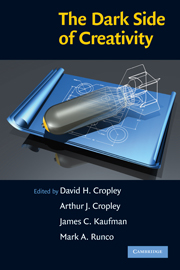Book contents
- Frontmatter
- Contents
- List of Contributors
- 1 The Dark Side of Creativity: What Is It?
- 2 Creativity Has No Dark Side
- 3 Positive Creativity and Negative Creativity (and Unintended Consequences)
- 4 Subjugating the Creative Mind: The Soviet Biological Weapons Program and the Role of the State
- 5 Imagining the Bomb: Robert Oppenheimer, Nuclear Weapons, and the Assimilation of Technological Innovation
- 6 The Innovation Dilemma: Some Risks of Creativity in Strategic Agency
- 7 Early Creativity as a Constraint on Future Achievement
- 8 Boundless Creativity
- 9 Reviewing the Art of Crime: What, If Anything, Do Criminals and Artists/Designers Have in Common?
- 10 Creativity in Confinement
- 11 Creativity and Crime: How Criminals Use Creativity to Succeed
- 12 So You Want to Become a Creative Genius? You Must Be Crazy!
- 13 Both Sides of the Coin? Personality, Deviance, and Creative Behavior
- 14 Neurosis: The Dark Side of Emotional Creativity
- 15 Dangling from a Tassel on the Fabric of Socially Constructed Reality: Reflections on the Creative Writing Process
- 16 Creativity in the Classroom: The Dark Side
- 17 The Dark Side of Creativity and How to Combat It
- 18 A Systems Engineering Approach to Counterterrorism
- 19 Malevolent Innovation: Opposing the Dark Side of Creativity
- 20 Summary – The Dark Side of Creativity: A Differentiated Model
- Index
- References
7 - Early Creativity as a Constraint on Future Achievement
Published online by Cambridge University Press: 05 June 2012
- Frontmatter
- Contents
- List of Contributors
- 1 The Dark Side of Creativity: What Is It?
- 2 Creativity Has No Dark Side
- 3 Positive Creativity and Negative Creativity (and Unintended Consequences)
- 4 Subjugating the Creative Mind: The Soviet Biological Weapons Program and the Role of the State
- 5 Imagining the Bomb: Robert Oppenheimer, Nuclear Weapons, and the Assimilation of Technological Innovation
- 6 The Innovation Dilemma: Some Risks of Creativity in Strategic Agency
- 7 Early Creativity as a Constraint on Future Achievement
- 8 Boundless Creativity
- 9 Reviewing the Art of Crime: What, If Anything, Do Criminals and Artists/Designers Have in Common?
- 10 Creativity in Confinement
- 11 Creativity and Crime: How Criminals Use Creativity to Succeed
- 12 So You Want to Become a Creative Genius? You Must Be Crazy!
- 13 Both Sides of the Coin? Personality, Deviance, and Creative Behavior
- 14 Neurosis: The Dark Side of Emotional Creativity
- 15 Dangling from a Tassel on the Fabric of Socially Constructed Reality: Reflections on the Creative Writing Process
- 16 Creativity in the Classroom: The Dark Side
- 17 The Dark Side of Creativity and How to Combat It
- 18 A Systems Engineering Approach to Counterterrorism
- 19 Malevolent Innovation: Opposing the Dark Side of Creativity
- 20 Summary – The Dark Side of Creativity: A Differentiated Model
- Index
- References
Summary
Most organizations, particularly those in volatile environments, recognize the need to stimulate creativity in their workforce because new and useful ideas can be highly profitable (Shalley & Perry-Smith, 2001). It is not surprising, then, that employees or teams that manage to develop a highly creative idea are rewarded with greater pay, recognition, and status (Merton, 1968). However, a highly successful creative idea also may lead to frustration, unmet expectations, and failed attempts to replicate success by producing poor imitations of one's early work. In other words, early creativity may constrain future achievement as people buckle under the weight of their past success.
There is abundant evidence that success can stifle creativity from biographies of eminent novelists. For instance, Ralph Ellison never produced another novel after the Invisible Man despite years of broken promises (and book contracts) that never materialized. It would appear that Harper Lee did not even make such an attempt; she retired shortly after writing her Pulitzer Prize–winning novel, To Kill A Mockingbird. This decision may have been a rational one on her part because even prolific writers seem to have trouble replicating early career success. For example, there was a 32-year gap between Norman Mailer's iconic first novel, The Naked and the Dead (1948), and his next critical and commercial hit, The Executioner's Song (1980). Furthermore, the constraining effects of creativity are not restricted to writers but may be a consequence of success in many fields.
- Type
- Chapter
- Information
- The Dark Side of Creativity , pp. 114 - 133Publisher: Cambridge University PressPrint publication year: 2010
References
- 13
- Cited by



